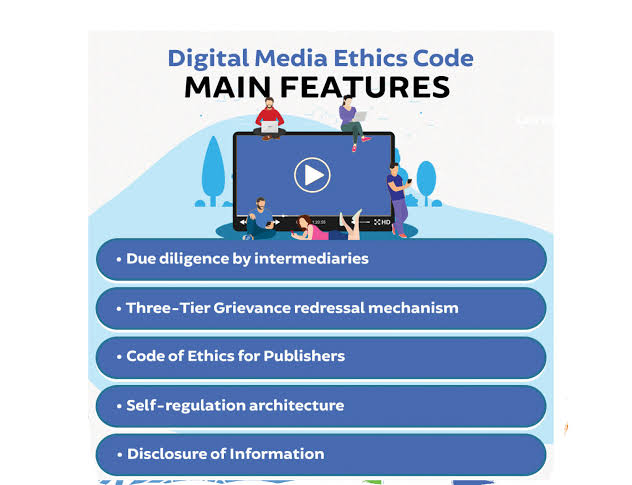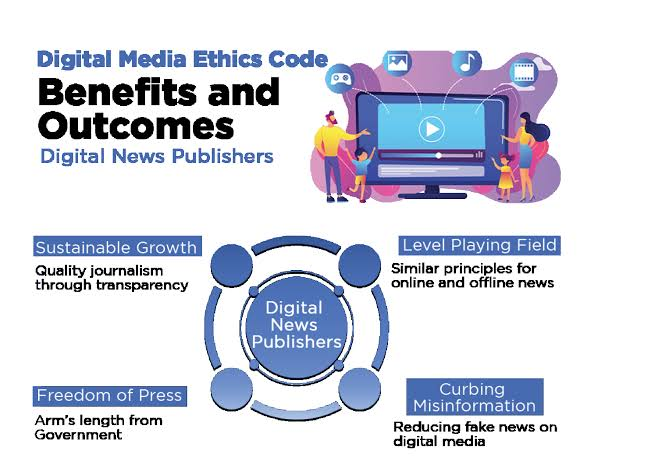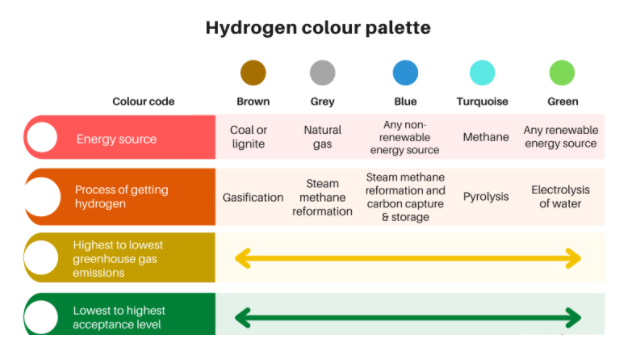GOVERNMENT’S RECENT MEASURES TO UPHOLD MEDIA ETHICS
Context
- Recently Cyber law experts and AIR correspondent should have been discussing the government issues and measures to uphold Media Ethics.
About Media Ethics
- Media ethics is the subdivision dealing with the specific ethical principles and standards of media, including broadcast media, film, theatre, the arts, print media and the internet.
- The field covers many varied and highly controversial topics, ranging from war journalism to Benetton ad campaigns.
- Media ethics promotes and defends values such as a universal respect for life and the rule of law and legality.
Media Ethics defines and deals with ethical questions about how media should use texts and pictures provided by the citizens.
Necessity of ethics in media:
- Media describes any channel of communication which can include anything from newspaper to digital data, and encompasses art, news, educational content and numerous other forms of information.
- The modern democratic edifice has been constructed drawing on the above and the individual liberty of expression of thought as the supreme principle.
- The press is an indispensable pillar of democracy. Parliamentary democracy can flourish only under the watchful eyes of the media. Media can make or unmake any individual, institution or any thought.
- With so much power and strength, the media cannot lose sight of its privileges, duties and obligations. However, to enjoy these privileges, it is mandated to follow certain ethics in collecting and disseminating the information, fairness in reporting.
- In the context of the press, “Ethics” may be described as a set of moral principles or values, which guide the conduct of journalism. The ethics are essentially the self-restraint to be practised by the journalists voluntarily, to preserve and promote the trust of the people and to maintain their own credibility.
The media all over the world has voluntarily accepted that code of ethics should cover at least the following areas of conduct.
- Honesty and fairness: duty of media to not falsify any information published.
- Example: The Daily Mail (London Based News Outlet)
- Respect for Privacy: media should respect the privacy of an individual as it can seriously affect the person’s life.
- Duty not to use dishonest means to obtain information.
- Duty not to prejudge the guilt of an accused and to publish the dismissal of charges against or acquittal.
- Example: In a court of law justice should be proved beyond reasonable doubt.
- Duty not to discriminate or to inflame hatred on such grounds as race, nationality, religion, or gender.
- Duty not to publish offensive materials.
- Duty not to endanger people.
Code of Ethics in Media:
- The code of ethics in media was created by a suggestion from the 1947 Hutchins Commission.
- They suggested that newspapers, broadcasters and journalists had started to become more responsible for journalism and thought they should be held accountable.
All-India Newspaper Editors' Conference (AINEC) code:
- In 1968, the All-India Newspaper Editors’ Conference (AINEC) formulated a code of ethics, according to which;
- The press has a vital role to play in the consummation of the fundamental objectives enshrined in our Constitution, namely, democracy, secularism, national unity and integrity and the rule of law.
- A free press can flourish only in a free society which is free of communalism.
- It is the duty of the press to help promote unity and cohesion in the hearts and minds of the people, and refrain from publishing material tending to excite communal passions or inflame communal hatred.
- Responsibility shall be assumed for all information and comments published.
PCI Code:
- Provocative and sensational headlines should be avoided;
- Headings must reflect and justify the matter printed under them;
- Figures of casualties given in headlines should preferably be on the lower side;
- Headlines containing allegations made in statements should either identify the personhody making the allegations or, at least, should carry quotation marks;
- Language employed in writing the news should be temperate and such as may foster the feeling of amity among communities and groups;
- Corrections should be promptly published with due prominence and regrets expressed in serious cases.
Code of Ethics:
In 1991, at the Stockholm Symposium, an International Code of Ethics was drafted and adopted. It applies to everyone working for the press and other media.
- The fundamental objective of a journalist is a fair, accurate and unbiased story.
- Unnamed sources should not be used unless the pursuit of truth will best be served by not naming the source.
- The journalists have a moral obligation to protect confidential sources of information.
- Corrections or clarifications should ‘be published for errors of fact promptly.
- The use of any obscene or tasteless language should be limited to quoted material.
- In principle, journalists should avoid paying for information unless public interest is involved.
- Plagiarism, i.e. using some one’s work without attribution, is a serious ethical breach and should be avoided.
Regulation of Media Overview:
- Self-regulation in the broadcast media is the best way forward in achieving a balance between the media’s duty to empower the participatory role of the people in governance and the reasonable restrictions that prevent the abuse of its immense strength.
- If it failed to exercise self-restraint and regulate its own conduct, then that would provide a justifiable reason for intervention from outside. Therefore, self-regulating is the best way so that there is no justification for any outside intervention to regulate.
- The existing bodies for regulation of media such as the Press Council of India (PCI) which is a statutory body and the News Broadcasting Standards Authority, a self-regulatory organization, issue standards which are more in the nature of guidelines.
- One of the best examples is the compliance of the media with the code of ethics framed by the National Broadcasters Association in the wake of the Mumbai terror attacks and the advisories issued from time to time.
About Information Technology (Intermediary Guidelines and Digital Media Ethics Code) Rules, 2021
- The Information Technology (Intermediary Guidelines and Digital Media Ethics Code) Rules, 2021, was notified by the Central government on February 25, 2021, relates to the digital news publishers, including websites, portals and YouTube news channels, and Over The Top (OTT) platforms, which stream online contents such as web series and films.
- It is jointly administered by the Ministry of Electronics and IT, and the Ministry of Information and Broadcasting.
- The Rules provide for a code of ethics to be followed by digital news publishers and OTT platforms; A three-tier grievance redress mechanism, which includes:
- Self-regulation by publishers at the first level
- Self-regulation by Self-regulating bodies of the publishers
- An oversight mechanism by the Central government.
Significance of the Information Technology (Intermediary Guidelines and Digital Media Ethics Code) Rules, 2021
- Digital media has grown over the past several years. Many new stakeholders such as online news portals, OTT platforms, etc. have become common on the internet.
- These rules provide an institutional mechanism for these entities, empower the citizens and protect the children from potentially harmful content while upholding the freedom of speech and expression of the citizens, including the press and the artists.
- The rules would ensure sustainable and long-term development of the media and entertainment sector in India while providing recognition and opportunities for the news media persons on the digital media.
Under which statute have the rules been framed? Will they be placed before Parliament?
- The Information Technology Act, 2000 is a law passed by the Parliament. The rules have been made under the Act and will be tabled in the Parliament.
Entities covered under Information Technology (Intermediary Guidelines and Digital Media Ethics Code) Rules, 2021
- The rules apply to publishers of news and current afairs, publishers of online curated content (commonly called OTT platforms) and intermediaries.

Which entities are publishers of news and current affairs on digital media?
- An online paper, news portal, news aggregator, news agency, etc. are publishers of news and current affairs content. Other entities who perform similar functions such as these are also publishers of news and current affairs content.
Does the Code of Ethics add new restrictions for news publishers?
- The Code of Ethics for digital news publishers stipulates that they follow existing laws; no new law or regulation has been prescribed.
- While some news websites may have already been following the norms for print and TV news media, the Code of Ethics only places it in perspective that digital news follow the Norms of Journalistic Conduct (applicable to print) and Programme Code under the Cable Television Networks Regulation Act (applicable to TV), thereby creating a level playing field in the news media industry.
Benefits and outcomes

READ: https://www.iasgyan.in/daily-current-affairs/information-technology-intermediary-guidelines-and-digital-media-ethics-rules-2021
Key issues
- The Rules may be going beyond the powers delegated under the Act in certain cases, such as where they provide for the regulation of significant social media intermediaries and online publishers, and require certain intermediaries to identify the first originator of the information.
- Grounds for restricting online content are overbroad and may affect freedom of speech.
- There are no procedural safeguards for requests by law enforcement agencies for information under the possession of intermediaries.
- Requiring messaging services to enable the identification of the first originator of information on its platform may adversely affect the privacy of individuals.
Certain grounds for restricting content may affect freedom of speech
- The Constitution allows for certain reasonable restrictions with respect to freedom of speech and expression on grounds such as national security, public order, decency, and morality.
- The IT Act prohibits uploading or sharing content which is obscene, sexually explicit, relates to child sex abuse, or violates a person’s privacy.
- The 2021 Rules specify certain additional restrictions on the types of information users of intermediary platforms can create, upload, or share.
- These include:
- “Harmful to child”,
- “Insulting on the basis of gender”, and
- “Knowingly and intentionally communicates any information which is patently false or misleading in nature but may reasonably be perceived as a fact”.
- Some of these restrictions are subjective and overbroad, and may adversely affect the freedom of speech and expression of users of intermediary platforms.
Regulation of online publishers under the 2021 Rules may be beyond the scope of the parent Act:
- The framework provides for norms and oversight mechanism for the regulation of content of online publishers.
- The press note by the central government on 2021 Rules noted that online publishers are digital platforms which are governed by the IT Act.
- The IT Act is aimed at providing legal recognition for transactions carried out by means of electronic data interchange and other means of electronic communication, and to facilitate electronic filing of documents.
- The Act prohibits cybercrime including publishing specified content such as sexually explicit content, child sex abuse material, and content violating other’s privacy.
- Laws such as the Press Council Act, 1978, the Press and Registration of Books Act, 1867, the Cable Television Networks (Regulation) Act, 1995, and the Cinematograph Act, 1952 are specific laws regulating publishers of news in print, television broadcast of news and audio-visual content, and films, respectively (similar content through other media).
- Regulation of content of these classes of publishers deals with questions of freedom of press and freedom of artistic expression.
- It may be questioned whether regulation of online publishers is envisaged under the IT Act and hence, if the 2021 Rules exceed the scope of the Act in this regard.
Wrapping it up
- The Rules define a social media intermediary as an intermediary which primarily or solely enables interaction between two or more users and allows them to create, upload, share, disseminate, modify or access information using its services.
- This definition may include any intermediary that enables interaction among its users.
- This could include email service providers, e-commerce platforms, video conferencing platforms, and internet telephony service providers.
https://newsonair.gov.in/Text-Bulletin-Details.aspx?id=43179

NEWS IN SHORT
GREEN HYDROGEN
Context
- Green Hydrogen has emerged as a promising pathway for meeting the decarbonisation goals.
About
- Hydrogen is one of the most abundant elements on Earth, and it represents to us a unique opportunity for a clean energy transition.
- Green hydrogen (GH2) and its derivatives will play a vital role in that transition.
- Hydrogen is classified as “green” – a clean and renewable energy carrier – when it is produced through electrolysis powered by renewable energy.
Hydrogen as a Fuel
- Hydrogen can be produced industrially from natural gas which generates significant carbon emissions. That type is known as “grey” hydrogen.
Blue Hydrogen
- A cleaner version is “blue” hydrogen, for which the carbon emissions are captured and stored, or reused.
Green Hydrogen
- The cleanest one of all is “green” hydrogen, which is generated by renewable energy sources without producing carbon emissions in the first place.

Importance of Green Hydrogen
- GH2 is versatile as it can be used as a combustion fuel or as feedstock for industrial processes.
- It can also be converted back into electricity in a fuel cell.
- Compared to grid renewable electricity, it can be more easily stored and transported over long distances for use further from the initial renewable energy source.
Derivatives of GH2
- Derivatives of GH2, such as green ammonia and green methanol, are long-term energy
- They store surplus renewable electricity produced during periods of low demand.
- Just like GH2, its derivatives can be used as industrial energy source, be used as green feedstock, or used as green transportation fuel.
India’s initiatives for boosting Green Hydrogen
- India has declared the goal to achieve Net Zero emissions by 2070. As India’s growth story unfolds, its demand for energy and resources is set to rise.
- India's National Green Hydrogen Mission is a government initiative aimed at promoting the use of hydrogen as a clean and renewable energy source in the country, and it has just received INR 19,700 crore rupees as a part of the national budget 2023.
- India has announced its long-term low-emission development strategy, that focuses on climate justice, sustainable lifestyles, and equity, at the ongoing UN climate summit in Egypt, joining a select group of fewer than 60 nations to do so.
Need for Green Hydrogen
- Energy use has doubled in the last 20 years and is likely to grow by at least another 25% by 2030.
- India currently imports over 40% of its primary energy requirements, worth over USD 90 billion every year.
- Major sectors like mobility and industrial production are significantly dependent on imported fossil fuels.
- This necessitates a shift towards technologies that enable enhanced share of renewable sources in the energy mix, and progressively reduce the reliance on fossil fuels.
Potential of Green Hydrogen
- Green Hydrogen, produced using renewable energy, has the potential to play a key role in such low-carbon and self-reliant economic pathways.
- Green Hydrogen can enable utilization of domestically abundant renewable energy resources across regions, seasons, and sectors, feeding multiple usage streams, either as a fuel or as an industrial feedstock.
- It can directly replace fossil fuel derived feedstocks in petroleum refining, fertilizer production, steel manufacturing
- Hydrogen fuelled long-haul automobiles and marine vessels can enable decarbonisation of the mobility sector.
Uses of Green Hydrogen
- Green Hydrogen can be particularly useful as a versatile energy carrier for meeting energy requirements of remote geographies, including islands, in a sustainable manner.
- The Green Hydrogen pathway can be a key enabler for India’s aspirations of building a low-carbon and self-reliant economy.
- It is therefore an opportune moment for India to launch the National Green Hydrogen Mission to scale up Green Hydrogen production and utilisation across multiple sectors and align with global trends in technology, applications, policy and regulation.
National Green Hydrogen Missio
Aim
- The Mission also aims to make India a leader in technology and manufacturing of electrolysers and other enabling technologies for Green Hydrogen.
Objective
- The overarching objective of the Mission is to make India the Global Hub for production, usage and export of Green Hydrogen and its derivatives.
- This will contribute to India’s aim to become Aatmanirbhar (self-reliant) through clean energy and serve as an inspiration for the global Clean Energy Transition.
- The Mission will lead to significant decarbonization of the economy, reduced dependence on fossil fuel imports, and enable India to assume technology and market leadership in Green Hydrogen.
Capability of Mission
- To achieve the above objectives, the Mission will build capabilities to produce at least 5 million Metric Tonne (MMT) of Green Hydrogen per annum by 2030, with potential to reach 10 MMT per annum with growth of export markets.
- The Mission will support replacement of fossil fuels and fossil fuel-based feedstocks with renewable fuels and feedstocks based on Green Hydrogen.
- This will include replacement of Hydrogen produced from fossil fuel sources with Green Hydrogen in ammonia production and petroleum refining, blending Green Hydrogen in City Gas Distribution systems, production of steel with Green Hydrogen, and use of Green Hydrogen-derived synthetic fuels (including Green Ammonia, Green Methanol, etc.) to replace fossil fuels in various sectors including mobility, shipping, and aviation.
Sourcing Green Hydrogen
- It is estimated that currently around 5 MMT (Million Metric Tonne) of Hydrogen is consumed annually in India for various industrial purposes like petroleum refining, manufacturing of ammonia for fertilizers, methanol production, treatment and production of metals etc.
- Most of this Hydrogen is currently sourced from fossil fuels through the process of steam reformation of natural gas, naptha and is referred to as Grey Hydrogen.
- The Chlor-alkali industry also produces Hydrogen gas as a by-product.
- Some Hydrogen is produced by electrolysis of water using grid electricity for specific applications.
Major components of green hydrogen
- The costs of the electrolysers and input renewable energy are the two major components of Green Hydrogen production cost.
- The costs of capital, supply and treatment of water, storage and distribution, conversion of hydrogen to suitable derivatives, and enabling infrastructure would also contribute significantly to the final delivered cost of Green Hydrogen for any particular application.
Demand
- About 5 MMT Grey Hydrogen is consumed annually in India, and about 99 percent of this quantity is utilized in petroleum refining and manufacture of Ammonia for fertilizers.
- In fertilizer production, Hydrogen is a key input for production of Ammonia (NH3), which is used to produce urea and other fertilizers.
- In petroleum refining, Hydrogen is mainly used for reducing sulphur content of fuels (desulphurization), and conversion of heavier feedstocks to more valuable products (hydrocracking).
- In both sectors, Grey Hydrogen can be substituted with Green Hydrogen, reducing carbon footprint and dependence on imported fossil fuels.
Significance
- Hydrogen can also be blended to a certain degree in most natural gas networks without requiring significant investments.
- Older networks will require retrofitting/upgradation of system components, but new and upcoming networks are likely to be compatible with high blend ratios of hydrogen.
- In order to create bulk demand and scale up production of Green Hydrogen, the Government of India will specify a minimum share of consumption of green hydrogen or its derivative products such as green ammonia, green methanol etc. by designated consumers as energy or feedstock.
Closing remark
- Considering the nascent status of the sector and the rapidly evolving profile of the industry, the mission is proposed to be implemented in a phased manner, focusing initially on deployment of Green Hydrogen in sectors that are already using hydrogen, and evolving an ecosystem for R&D, regulations and pilot projects. PHASE I from (2022-23 TO 2025-26) and PHASE II (2026-27 TO 2029-30).
https://newsonair.gov.in/Main-News-Details.aspx?id=458676

ORGAN DONATION
Context
- Prime Minister Narendra Modi today urged people to come forward for organ donation.
Details
- Organ Donation is the gift of an organ to a person with end stage organ disease and who needs a transplant.
- The organs that can be donated are: Liver, Kidney, Pancreas, Heart, Lung, Intestine.
- The tissues that can be donated are: Cornea, Bone, Skin, Heart Valve, blood vessels, nerves and tendon etc.
Age limit for Organ Donation
- Age limit for Organ Donation varies, depending upon whether it is living donation or cadaver donation;
- For example, in living donation, person should be above 18 years of age, and for most of the organ’s deciding factor is the person physical condition and not the age.
- Specialist healthcare professionals decide which organs are suitable case to case.
- Organs and tissue from people in their 70s and 80s have been transplanted successfully all over the world.
- In the case of tissues and eyes, age usually does not matter.
- A deceased donor can generally donate the Organs & Tissues with the age limit of:
- Kidneys, liver: up-to 70 years
- Heart, lungs: up-to 50 years
- Pancreas, Intestine: up-to 60-65 years
- Corneas, skin: up-to 100 years
- Heart valves: up-to 50 years
- Bone: up-to 70 years
Types of organ donation
- Living Donor Organ Donation: A person during his life can donate one kidney (the other kidney is capable of maintaining the body functions adequately for the donor), a portion of pancreas (half of the pancreas is adequate for sustaining pancreatic functions) and a part of the liver (the segments of liver will regenerate after a period of time in both recipient and donor).
- Deceased Donor Organ Donation: A person can donate multiple organ and tissues after (brain-stem/cardiac) death. His/her organ continues to live in another person body.
Legal procedure for organ transplantation
- Organ Transplantation and Donation is permitted by law, and covered under the "Transplantation of Human Organs Act 1994", which has allowed organ donation by live & Brain-stem Dead donors.
- In 2011, amendment of the Act also brought in donation of human tissues, there by calling the Amended Act "Transplantation of Human Organs & Tissues Act 2011.
https://newsonair.gov.in/News?title=Mann-ki-Baat%3A-PM-Modi-urges-people-to-take-precautions-in-view-of-rising-COVID--19-cases%3B-Says%2C-Government-working-on-uniform-policy-for-organ-donation-in-the-country&id=458212
FREE ONLINE UPDATION OF DOCUMENTS IN AADHAAR
Context
- UIDAI makes online document updation in Aadhaar free of cost.
Detail
- The Unique Identification Authority of India, UIDAI has decided to allow residents to update documents in their Aadhaar online free of cost.
- The service is free only on myAadhaar portal and will continue to attract a fee of 50 rupees at physical Aadhaar centres.
- The UIDAI has been encouraging residents to upload Proof of Identity and Proof of Address documents to revalidate their demographic details, especially if Aadhaar was issued 10 years back and never got updated.
About UIDAI
- The Unique Identification Authority of India or UIDAI is an agency under the central government of India mandated to collect demographic and biometric information of the country’s residents, store the data in a central database, and issue to each resident of the country a 12-digit unique identity number called Aadhaar.
- UIDAI was established as per the Aadhaar (Targeted Delivery of Financial and Other Subsidies, Benefits and Services) Act, 2016.
- The act is also called the Aadhaar Act 2016 in short.
- It comes under the Electronics & IT ministry.
READ: https://www.iasgyan.in/daily-current-affairs/aadhar-card
https://newsonair.com/2023/03/16/uidai-decides-to-allow-residents-to-update-documents-in-their-aadhaar-online-free-of-cost/
.jpg)
RBI MONETARY POLICY COMMITTEE DECISION TO KEEP THE REPO RATE UNCHANGED
Context
- RBI keeps repo rate unchanged at 6.5 percent.
About
- Repo rate is the rate at which RBI lends to banks generally against government securities while the reverse repo is the rate at which RBI borrows money from the banks.
- Both these rates are key determinants for customers availing loans from banks.
- A pause in the rate hike comes after six successive rate hikes.
- In its last monetary policy review announced in February 2023, RBI raised the repo rate by 25 basis points to 6.50 percent.
- The repo rate has seen an increase of 250 basis points since May last year, primarily to contain inflation.
https://newsonair.gov.in/News?title=RBI-Governor-Shaktikanta-Das-to-announce-decisions-taken-by-Monetary-Policy-Committeemeeting&id=458883#:~:text=While%20announcing%20the%20first%20bi,act%20should%20the%20situation%20warrant.







